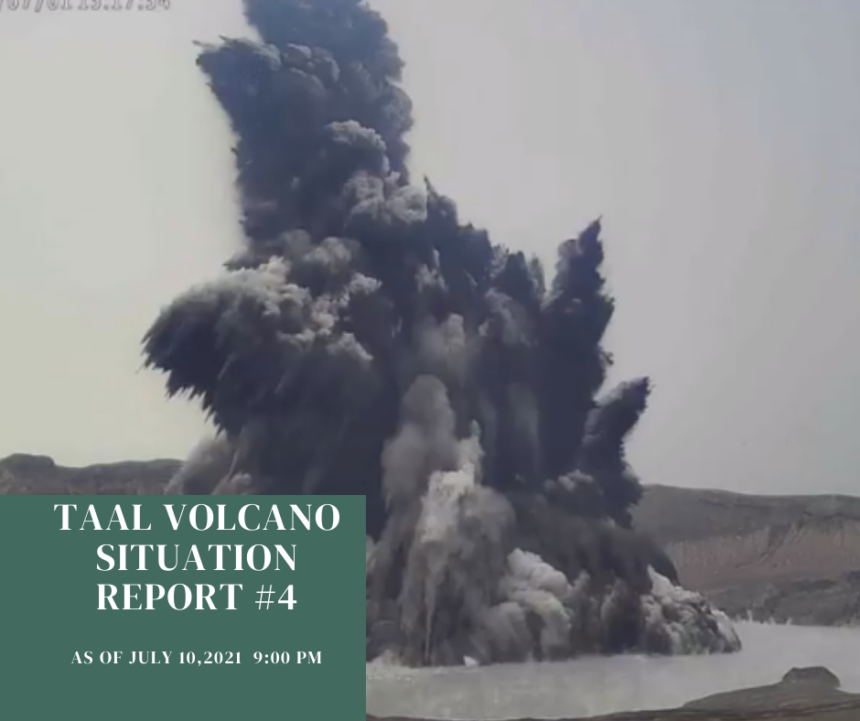Situation Overview
• On July 08, five (5) short phreatomagmatic bursts was seen. Taal Volcano also produced short jetted plumes that rose up to 700 meters above the Main Crater Lake. It has also recorded sixty-one (61) volcanic earthquakes, with five (5) explosion-type earthquakes, twenty-four (24) low frequency volcanic earthquakes, twenty-one (21) volcanic tremor events having durations of two (2) to four (4) minutes, ten (10) hybrid earthquakes, and low-level background tremor that ended yesterday at 06:21 PM but resumed at 09:52 PM.
• On July 9, another series of 5 small phreatomagmatic eruptions occurred accompanied with 58 volcanic earthquakes with low-level background tremor that persisted since 07 July 2021.
• In the past 24-hour period of July 10, the Taal Volcano Network recorded eight (8) volcanic earthquakes, including one (1) volcano-tectonic earthquake, two (2) low frequency volcanic earthquakes, five (5) volcanic tremor events having durations of one (1) to two (2) minutes, and low-level background. High levels of volcanic sulfur dioxide or SO2 gas emissions and steam-rich plumes that rose one thousand two hundred (1,200) meters before drifting generally west was generated from the Taal Main Crater.
• The highest SO2 emission remains at 22,628 tons per day recorded on July 4, 2021. According to PHIVOLCS, volcano emits SO2 when magma is relatively close to the surface.
• As of this writing, Alert Level 3 (Magmatic Unrest) is still elevated over Taal. At Alert Level 3, magma extruding from the Main Crater could drive explosive eruption. The public is reminded that the entire Taal Volcano Island is a Permanent Danger Zone (PDZ), and entry into the island as well as into the high-risk barangays of Agoncillo and Laurel must be prohibited due to the hazards of pyroclastic density currents and volcanic tsunami should strong eruptions occur. All activities on Taal Lake should not be allowed at this time. Communities around the Taal Lake shores are advised to remain vigilant, take precautionary measures against possible airborne ash and fog and calmly prepare for possible evacuation should unrest intensify.
Source: (DOST-Phivolcs, DSWD DROMIC Report and NDDRMC)
Affected Populations
• As of July 9, in the data submitted by Southern Tagalog People’s Response Center (STPRC), a total of 96 families or 372 individuals are currently staying in 5 evacuation centers in As-is, Niyugan, San Gregorio, Bilaran in Laurel Batangas.
• A total of 65 families or 243 individuals were reported to have fled their homes in Agoncillo town. Of which, 29 families or 108 persons are temporarily staying with their relatives and/or friends in CALABARZON.
• In the report released by DWSD, a total of 2,744 families or 9,889 persons were affected by the Taal Volcano eruption in 66 Barangays in CALABARZON. Of which, 1,086 families or 3,789 persons are currently taking temporary shelter in 23 evacuation centers in CALABARZON while 1,337 families or 4,821 persons are outside evacuation centers or opted to stay with their relatives or friends.
• According to the rapid assessment conducted by STPRC, some residents who have fled their homes but remain outside designated evacuation centers are struggling to get food and other necessities these past few days. Most of the evacuees are also in dire need for basic necessities including health kits such as facemasks and alcohol to protect them from the COVID-19 virus.
Source: (DOST-Phivolcs, DSWD DROMIC Report, NDDRMC & STPRC)
Emergency Response Efforts
• CDRC is closely monitoring the situation in coordination through PHIVOLCS updates.
• CDRC is also closely coordinating with its regional center in affected areas to collect information on the situation and needs of the ground and constantly updating situation reports.
• On July 2, CDRC’s regional center “Southern Tagalog People’s Response Center (STPRC)” has mobilized a Rapid Damage Assessment and Needs Analysis team to conduct assessments in the affected areas while CDRC’s assessment team are placed on standby for possible mobilization.
• CDRC begins to release situation reports and posting updates and photos of the situation on their official FB page CDRC-Official Facebook Page including publicizing information like precautionary tips in case of a volcanic eruption.
Resources Available
• Standby emergency funds
• Prepositioned goods at the CDRC warehouse
• Monetary and in-kind donations
Expressed Needs
• Food supplies
• Clean water
• Hygiene kits
• Facemasks
• Primary medicines
• Sleeping materials
• Family tents
Coordination
1. Regional Center
Southern Tagalog People’s Response (STPRC)
Contacts
1. Hanna Fiel, Deputy Executive Director, 0945-8355589, hanna.fiel.cdrc2019@gmail.com
2. Cora Jazmines, Local Partnerships Department, 0928-182-4969, lpd@cdrc-phil.com

